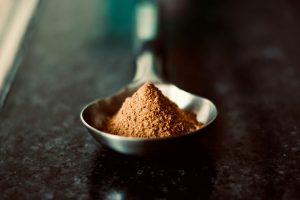What is the best substitute for Cocoa Powder?
Do you want to learn what the best substitute for cocoa powder is? Indulging in a chocolate treat is one of life’s simple pleasures, but what if you run out of cocoa powder? In this article, we list what we think are the best substitutes for cocoa powder that will help you conquer your chocolate cravings in no time. Whether you’re a baking enthusiast or simply enjoy a warm mug of hot chocolate, there are several alternative ingredients that can replicate the rich flavor of cocoa powder.
From spices like cinnamon and nutmeg to superfoods like carob powder and cacao nibs, we’ll explore a variety of options that will keep your taste buds satisfied. Discover how you can infuse your recipes with a delicious twist by substituting cocoa powder while still maintaining that decadent chocolate taste.
We will also provide you with useful tips on how to use these alternatives in different recipes, ensuring that you achieve the perfect balance of flavor and texture. So, if you’re ready to embark on a culinary journey that celebrates the versatility of chocolate, let’s dive in and explore the best substitutes for cocoa powder that will transform your creations into chocolatey delights.
Try using: Unsweetened Cooking Chocolate, Dark Chocolate, Dutch-process Cocoa, Carob Powder, Roasted Beet Powder, Espresso Powder, Cinnamon and Nutmeg, Hot Chocolate Powder, Chocolate chips/nibs.
What is Cocoa Powder?
Cocoa powder is a rich, flavorful powder made from roasted and processed cocoa beans. It’s a key ingredient in many desserts and beverages, like chocolate cakes, brownies, hot cocoa, and chocolate milk.
The choice of cocoa powder can be a bit daunting, so here is some information on the most common ones:
- Natural cocoa Powder: has a strong bitter flavor. Its natural acidity helps activate leavening agents in baking, making it ideal for cakes, brownies, and muffins.
- Dutch-process Cocoa Powder: This type is treated with an alkali (often potassium carbonate) to neutralize its acidity, resulting in a smoother, milder flavor powder. It does have a darker color and higher pH level than natural cocoa powder. It’s great for recipes where leavening isn’t crucial, like chocolate puddings, mousses, and hot cocoa.
- Black Cocoa Powder: This is an ultra-Dutch-processed cocoa powder, making it the darkest and most alkaline of the bunch. Its flavor is very mild, almost nutty, with less of the traditional chocolatey taste. It’s primarily used for its intense black color in recipes like Oreos, chocolate cookies, and dark chocolate cakes. Its neutral pH level doesn’t activate leavening agents, so it may not be suitable for all baking applications.
- Red Cocoa Powder: This type falls somewhere between Dutch-process and black cocoa powder in terms of processing and color. It has a deeper, burgundy-red hue and a slightly bitter flavor compared to regular Dutch-process cocoa powder. It’s ideal for adding a richer, more complex flavor and a distinctive reddish color to pastries and baked goods like fudgy brownies and red velvet cake.
What can I substitute for Cocoa Powder?
Here are some of the best ingredients to substitute the flavor and role that cocoa powder provides in your recipes.
- Unsweetened cooking chocolate
- Dark chocolate
- Dutch-process cocoa
- Carob Powder
- Roasted Beet Powder
- Espresso Powder
- Cinnamon and Nutmeg
- Hot chocolate powder
- Chocolate chips/nibs
Cocoa Powder substitutes
Unsweetened Cooking Chocolate
You can definitely use unsweetened cooking chocolate as a substitute for cocoa powder, but it involves some adjustments to keep your recipe balanced while still acheiving the desired taste and texture. Here’s how to do it:
Ratio and Adjustments:
- General rule: Use 2 tablespoons of melted unsweetened cooking chocolate for every 3 tablespoons of cocoa powder.
- Fat content: Unsweetened cooking chocolate already contains cocoa butter, a natural fat, which is not present in cocoa powder. Therefore, reduce the amount of fat called for in your recipe by 1 tablespoon for every 2 tablespoons of chocolate substituted. This accounts for the added fat from the chocolate.
- Liquid adjustments: Depending on your recipe, you might need to adjust the liquids slightly. The added chocolate can sometimes make the batter or dough slightly thicker, so add a tablespoon or two of additional liquid (milk, water, etc.) if needed to achieve the desired consistency.
Flavor and Texture:
- Flavor: Unsweetened cooking chocolate will add a richer, deeper chocolate flavor compared to cocoa powder, but it will lack the slight bitterness cocoa powder provides. If you prefer a slightly bitter taste, consider adding a teaspoon of unsweetened cocoa powder with the melted chocolate for balance.
- Texture: The added fat from the chocolate can lead to a denser, fudgier texture in baked goods. This can be desirable in some cases, like brownies or mousse, but if you prefer a lighter texture, consider using a combination of cocoa powder and melted chocolate, adjusting the amounts as needed.
Tips:
- Choose high-quality unsweetened baking chocolate with at least 70% cacao content for the best flavor and results.
- Melt the chocolate gently in a bowl over a pan of simmering water (don’t let the water touch the bowl) or in short bursts in the microwave, stirring frequently, to prevent burning.
- Let the melted chocolate cool slightly before adding it to your recipe to avoid affecting the final temperature of your batter or dough.
Overall, using unsweetened cooking chocolate as a substitute for cocoa powder can add a richer, denser, and more decadent touch to your recipes. Just remember the adjustments for fat content, liquid, and flavor preferences to achieve the perfect result!
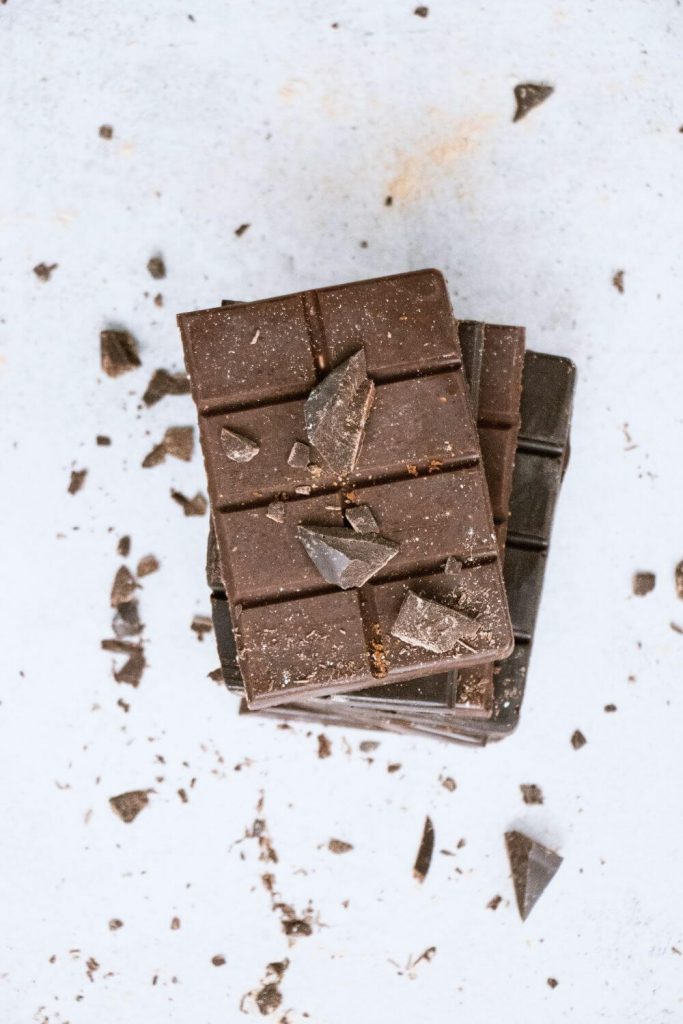
Dark Chocolate
You can definitely use dark chocolate as a substitute for cocoa powder, but like with unsweetened cooking chocolate, it requires some adjustments for a successful conversion. Here’s how to do it:
Ratio and Adjustments:
- General rule: Use 1 ounce (2 tablespoons) of finely chopped or grated dark chocolate for every 3 tablespoons of cocoa powder.
- Fat content: Dark chocolate, especially with higher cacao percentages, contains cocoa butter, which again needs to be accounted for. Reduce the amount of fat called for in your recipe by 1 tablespoon for every ounce of chocolate substituted.
- Liquid adjustments: As with unsweetened baking chocolate, the added fat might require slightly more liquid. Start with the original recipe amount and add a tablespoon or two of liquid (milk, water) if the batter or dough seems too thick.
- Sweetness adjustments: Keep in mind that dark chocolate adds sweetness along with flavor. If your recipe already calls for sugar, consider reducing the sugar by 1-2 tablespoons depending on the cacao content of your chocolate (higher cacao means more bitterness).
Flavor and Texture:
- Flavor: Dark chocolate substitutes offer a richer, more complex chocolate flavor compared to cocoa powder, with pronounced notes depending on the origin and percentage of cacao. You might lose the slight bitterness you get from cocoa powder, but depending on your taste, that might be preferable.
- Texture: Similar to unsweetened chocolate, dark chocolate can lead to a denser, fudgier texture, which can be great for brownies or mousses. If you prefer a lighter cake or cookie, consider using a combination of cocoa powder and dark chocolate, adjusting the amounts for your desired outcome.
Tips:
- Choose high-quality dark chocolate with at least 60% cacao content for the best flavor and results. Avoid milk chocolate as it’s too sweet and the flavor might get lost in baking.
- Finely chop or grate the chocolate for easier distribution and incorporation into your batter or dough.
- Melt the chocolate briefly if you want a smoother texture in specific recipes, but generally, finely chopped/grated works well.
- Remember, these are general guidelines. Consider adjusting further based on your specific recipe and desired taste and texture.
Using dark chocolate as a substitute opens up a world of richer and more nuanced chocolate flavors in your recipes. Play around with different cacao percentages and combinations with cocoa powder to discover your perfect chocolatey creations!
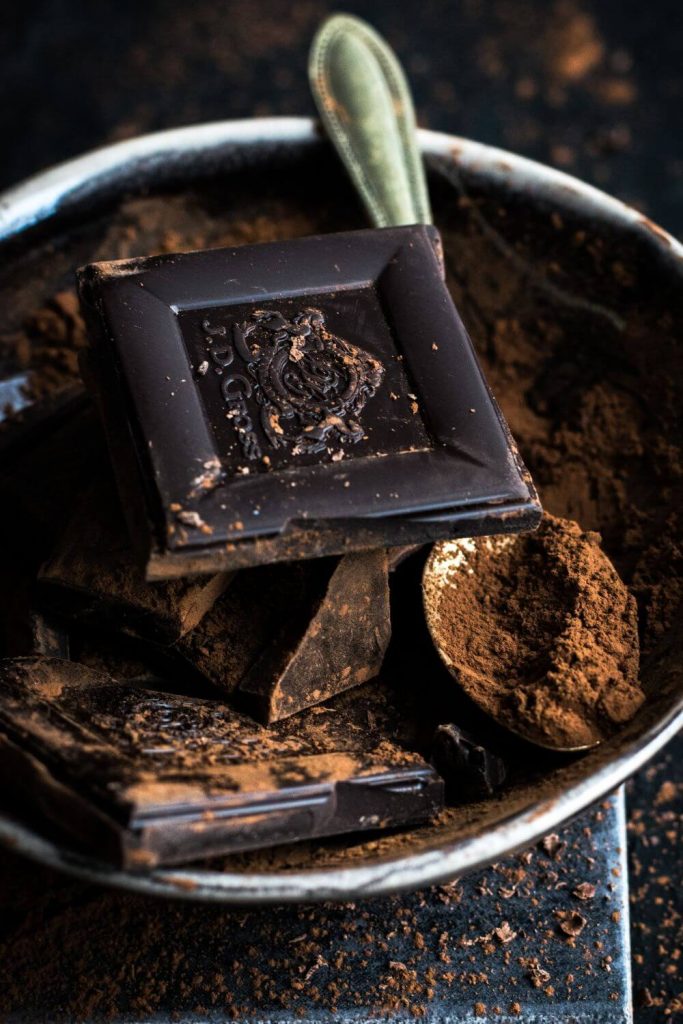
Dutch-process Cocoa
Dutch processed cocoa (or alkalized) powder is treated with an alkaline to reduce the acidity of the cocoa. This gives it a milder, smoother flavour and also a darker colour. Here’s how you can use Dutch-process cocoa as a substitute for “cocoa powder”.
Ratio:
Generally, you can use a 1:1 ratio for substitution. However, keep in mind the key differences between Dutch-process and natural cocoa powder:
Flavor:
Dutch-process cocoa has a milder, smoother flavor and less bitterness compared to natural cocoa. This might be desirable in some recipes, especially for frostings, mousses, and hot cocoa. However, if you want that classic cocoa flavor with a bit of an edge, you might miss the slight bitterness of natural cocoa.
Color:
Dutch-process cocoa is darker than natural cocoa. This can add a richer visual element to your baked goods, like brownies and cakes.
pH Level:
Dutch-process cocoa has a higher pH level (less acidic) than natural cocoa. This means it doesn’t activate leavening agents like baking soda as effectively. So, if your recipe relies on baking soda for rise and uses natural cocoa, substituting with Dutch-process might result in denser baked goods.
Tips:
- If your recipe relies on baking soda for leavening, consider adding a small amount of baking powder (about 1/2 teaspoon for every 3 tablespoons of cocoa) to compensate for the neutralized acidity of Dutch-process cocoa.
- If you prefer a slightly more complex flavor in your baked goods, consider using a combination of Dutch-process and natural cocoa powder. Start with a 2:1 ratio of Dutch-process to natural and adjust to your taste.
- Remember, these are just guidelines. Consider adjusting based on your specific recipe and desired results.
Overall, while substituting Dutch-process cocoa for “cocoa powder” generally won’t cause major problems, be mindful of the flavor and leavening differences to ensure your recipe still turns out delicious!
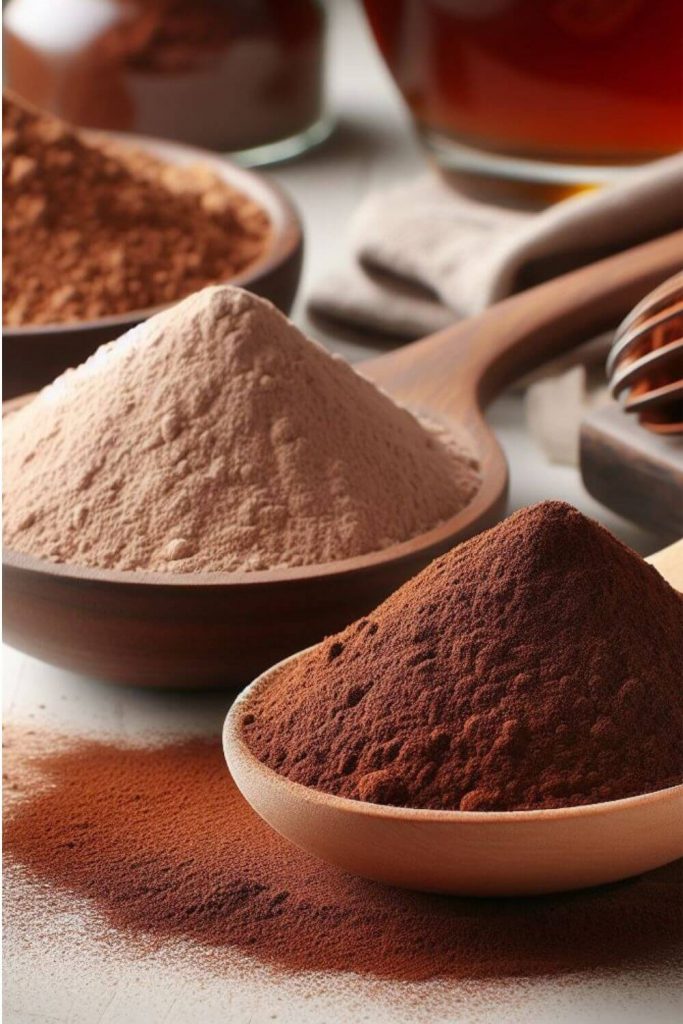
Carob Power
Using carob powder as a substitute for cocoa powder offers a healthier and caffeine-free alternative, but it comes with some adjustments to ensure your recipe still delivers in flavor and texture. Here’s how to successfully make the switch:
Ratio and Adjustments:
- General rule: You can use a 1:1 ratio of carob powder for cocoa powder in most recipes. However, keep in mind that carob powder is sweeter than cocoa powder.
- Sweetness adjustments: Start with the original recipe amount of sugar and reduce it by about 1/3 to 1/2 depending on your taste and the carob powder you’re using. Taste-test as you go and adjust further if needed.
- Liquid adjustments: Carob powder can absorb moisture differently than cocoa powder. Start with the original recipe amount of liquid and add a tablespoon or two more if the batter or dough seems too dry.
- Flavor adjustments: Carob powder has a naturally sweet, slightly nutty and toasty flavor, distinctly different from chocolate. If you miss the bitterness of cocoa, consider adding a pinch of espresso powder or strong brewed coffee for a deeper flavor profile.
Texture:
Carob powder can sometimes lead to a slightly denser texture compared to cocoa powder. This can be desirable in some recipes like brownies, but if you prefer a lighter bake, consider combining carob powder with a small amount of unsweetened cocoa powder (start with a 2:1 ratio and adjust further if needed).
Tips:
- Choose high-quality carob powder for the best flavor and results. Organic options are readily available.
- If using carob powder in hot cocoa, it might not achieve the same frothy texture as cocoa powder. However, it still makes a warm and flavorful drink.
- Remember, these are just guidelines. Be prepared to adjust based on your specific recipe and desired taste and texture. Don’t hesitate to experiment and find what works best for you!
Using carob powder as a substitute for cocoa powder opens up a healthier and caffeine-free world of baking and cooking. Embrace its unique flavor and enjoy the creative possibilities it offers!
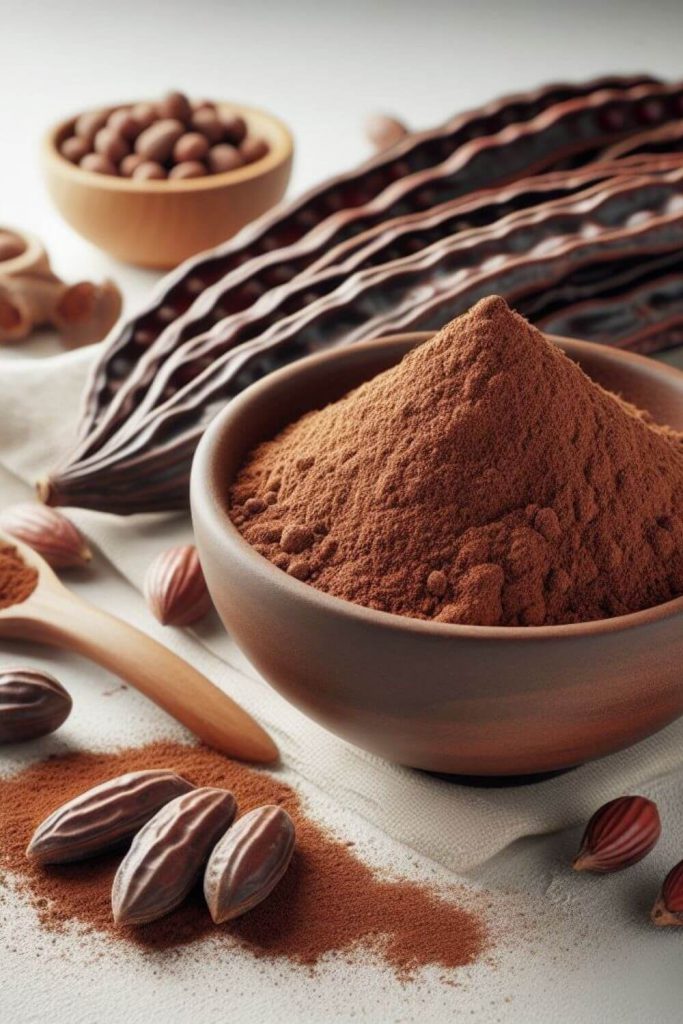
Roasted Beet Powder
While roasted beet powder can’t entirely replicate cocoa powder’s flavor and texture, it can add a beautiful earthy sweetness and vibrant red hue to certain recipes, opening up exciting creative possibilities! Here’s how to use it as a substitute:
Flavor and Color:
- Flavor: Remember, roasted beet powder offers a sweet, earthy taste, quite different from chocolate’s richness. It works well in recipes where you want a subtle sweetness and earthy depth, like muffins, pancakes, breads, and even savory crackers. However, it’s not a direct replacement for the complex chocolatey notes of cocoa powder.
- Color: Roasted beet powder shines in its vibrant red color, perfect for adding a natural blush to cookies, frostings, and even macarons. Be aware that the color tends to bleed during baking, so adjust your expectations and embrace the unique aesthetic it brings.
Substitution Tips:
- Ratio: Generally, use a 1:2 ratio of roasted beet powder to cocoa powder. This means if a recipe calls for 3 tablespoons of cocoa powder, start with 1 1/2 tablespoons of roasted beet powder and adjust to your taste preference.
- Sweetness: Roasted beet powder itself is naturally sweet, so you might need to reduce the added sugar in your recipe by 1/4 to 1/3, depending on your desired sweetness level.
- Moisture: Beet powder can absorb moisture differently than cocoa powder. Start with the original recipe amount of liquid and add a tablespoon or two more if the batter seems too dry.
- Texture: Due to its different properties, roasted beet powder might not always create the same fluffy texture as cocoa powder. This is especially true in cakes and mousses. However, it can add a delightful chewiness to cookies and pancakes.
Creative Ideas:
- Combine beetroot and cocoa: Don’t shy away from using both! A 1:1 ratio of roasted beet powder and cocoa powder can create a unique flavor profile with layers of sweetness, earthiness, and chocolatey depth. Perfect for brownies, muffins, and even hot cocoa!
- Embrace the color: Highlight the vibrant red hue! Beet powder adds a stunning natural color to frostings, icings, and even marzipan. Play with colors and create visually stunning desserts.
- Go savory: Don’t limit yourself to sweets! Roasted beet powder adds a subtle sweetness and earthy depth to savory crackers, breads, and even dips. Experiment and discover unexpected flavor combinations.
Remember, substituting roasted beet powder for cocoa powder is an adventure in creativity! Embrace the different flavor and texture profiles, adjust with care, and most importantly, have fun exploring the unique possibilities it offers!
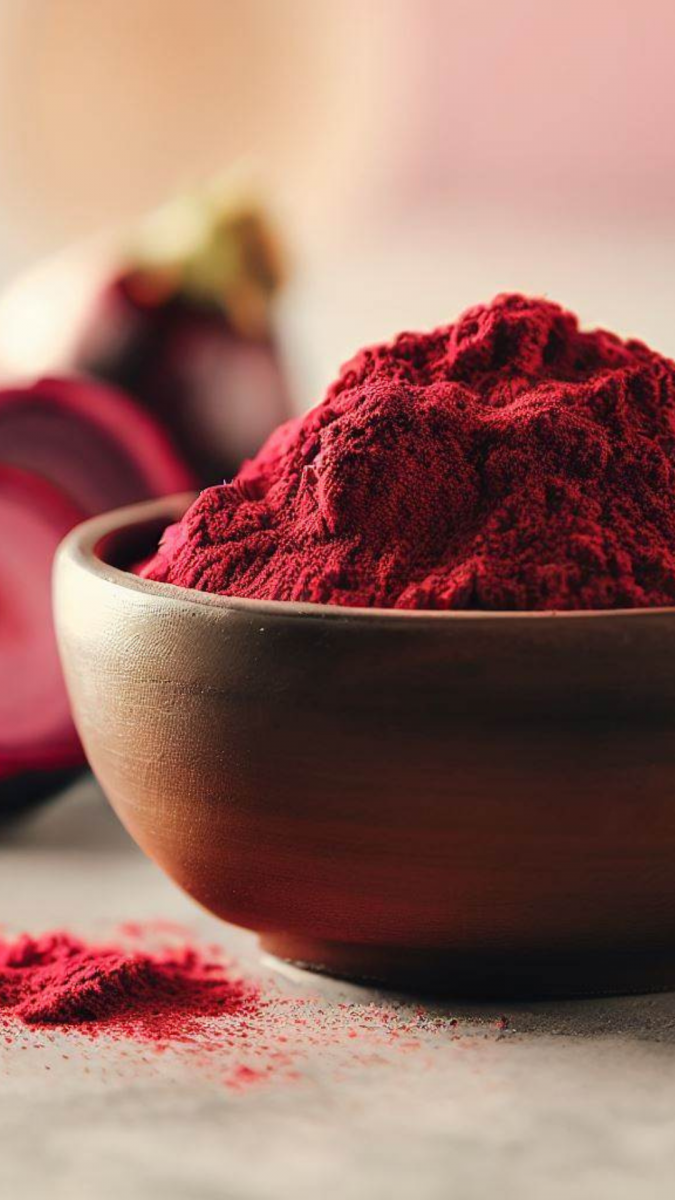
Espresso Powder
Using espresso powder as a substitute for cocoa powder can add an intriguing twist to your recipes, but it’s crucial to understand the differences and adjust accordingly to achieve the desired outcome. Here’s how to navigate this substitution:
Flavor and Texture:
- Flavor: Espresso powder packs a powerful punch of coffee flavor, adding depth and complexity compared to cocoa’s chocolatey notes. It also adds a touch of bitterness, so be mindful of the final taste profile you’re aiming for.
- Texture: Espresso powder doesn’t contribute significant texture like cocoa powder, but it can slightly thicken batters due to its moisture absorption.
Substitution Tips:
- Ratio: Start with a much smaller amount of espresso powder compared to cocoa. A good rule of thumb is 1 teaspoon of espresso powder for every 3 tablespoons of cocoa powder. Taste-test and adjust based on your preference for coffee intensity.
- Sweetness: The bitterness of espresso might require you to increase the sugar content by 1-2 tablespoons depending on your recipe and taste.
- Liquid adjustments: Espresso powder absorbs moisture, so you might need to add a tablespoon or two of extra liquid like milk or water if the batter seems too dry.
- Flavor pairings: Espresso powder works well with chocolate flavors, enhancing their depth. Consider using it in combination with dark chocolate or cocoa powder for a richer coffee-chocolate experience.
Best Use Cases:
- Cakes and brownies: A small amount of espresso powder can add a subtle coffee nuance to chocolate desserts without overpowering the main flavor.
- Mousse and frostings: Infuse a hint of coffee aroma and bitterness to elevate these creamy treats.
- Cookies and bars: Espresso powder adds depth and complexity to chewy cookies and oat bars.
- Savory dishes: Experiment with small amounts in marinades, rubs, or even dips for a unique savory coffee boost.
Things to Remember:
- Espresso powder intensifies other flavors, so adjust spices and extracts accordingly.
- The caffeine content of espresso powder is significant, so it’s not suitable for children or caffeine-sensitive individuals.
- Start with a light touch and gradually adjust to your desired taste profile.
Substituting espresso powder for cocoa powder offers exciting possibilities for adding complexity and depth to your recipes. Be adventurous, adjust with care, and have fun exploring the unique coffee-infused creations!
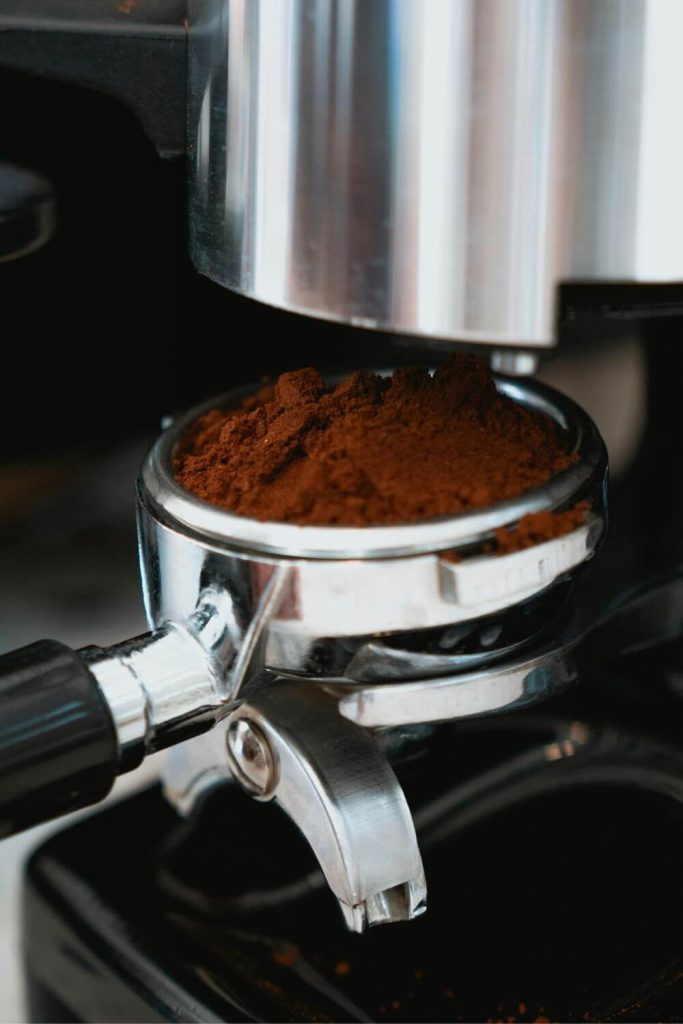
Cinnamon and Nutmeg
Cinnamon and nutmeg can add a warm and aromatic flavor to your recipes, but it’s important to note that they won’t exactly replicate the deep, chocolatey taste of cocoa powder. However, if you’re looking to experiment and create a unique twist, here’s how you can use cinnamon and nutmeg as a substitute:
Cinnamon and Nutmeg Hot Chocolate:
Create a cozy spiced hot chocolate using cinnamon and nutmeg.
Ingredients:
- 2 cups of milk
- 2 tablespoons sugar
- 1 teaspoon ground cinnamon
- 1/2 teaspoon ground nutmeg
- 1/2 teaspoon vanilla extract
- Whipped cream (optional)
Instructions:
- In a saucepan, heat the milk over medium heat until warm but not boiling.
- Add sugar, ground cinnamon, ground nutmeg, and vanilla extract.
- Whisk the mixture until well combined and heated through.
- Pour into mugs, and if desired, top with whipped cream.
Cinnamon and Nutmeg in Baking:
If you’re substituting for cocoa powder in a baking recipe, consider the following ratios:
For every 1 tablespoon of cocoa powder, use: 1 teaspoon ground cinnamon and 1/4 teaspoon ground nutmeg.
Adjust these ratios based on your taste preferences. Keep in mind that this will introduce a spiced flavor rather than a chocolatey one.
Cinnamon and Nutmeg Coffee:
Enhance your morning coffee with a hint of spice.
Ingredients:
- Freshly brewed coffee
- Ground cinnamon
- Ground nutmeg
- Sweetener of your choice (optional)
Instructions:
- Brew your coffee as usual.
- Sprinkle a pinch of ground cinnamon and nutmeg into your coffee.
- Stir well and add sweetener if desired.
Remember, while cinnamon and nutmeg can add warmth and complexity to your recipes, they won’t provide the chocolate flavor that cocoa powder does. It’s all about exploring new flavors and finding what suits your palate!
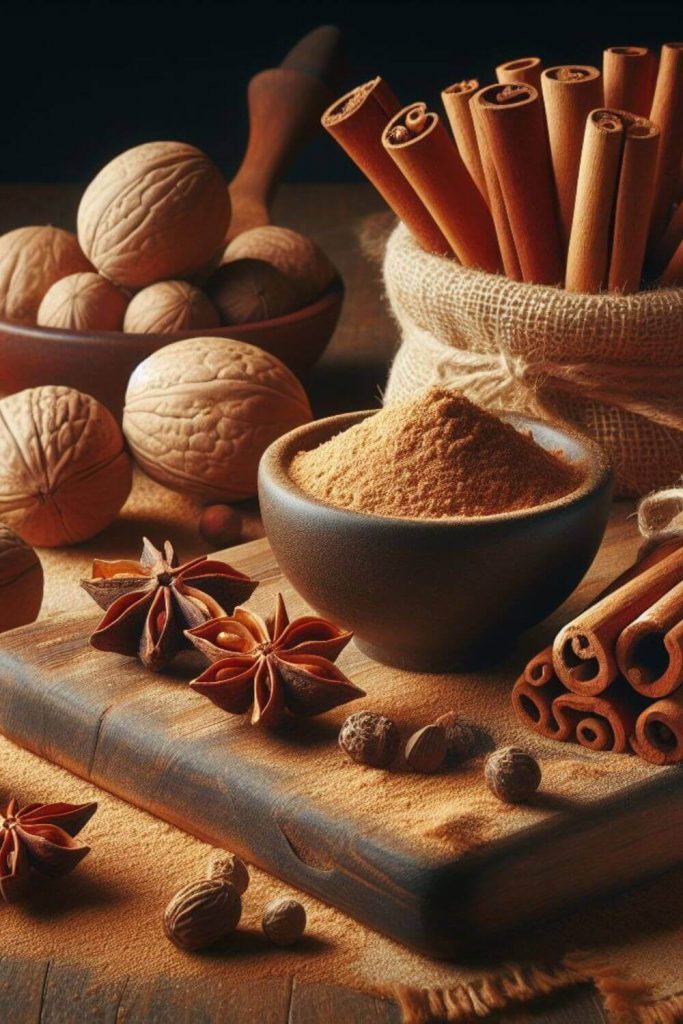
Hot Chocolate Powder
While using Hot Chocolate Powder as a substitute for cocoa powder can work in a pinch, it does come with some adjustments to achieve the desired results. Here’s how you can make the switch:
Flavor and Consistency:
- Flavor: Hot Chocolate Powder typically contains cocoa powder, sugar, milk solids, and often flavorings like vanilla or marshmallows. This means it offers a sweeter, milkier taste compared to the pure chocolate flavor of cocoa powder. You might miss the depth and bitterness of natural cocoa powder.
- Texture: Hot Chocolate Powder can sometimes lead to a denser, heavier texture compared to cocoa powder, especially in baked goods. It can also thicken liquids more readily.
Substitution Tips:
- Ratio: Generally, you can use a 1:1 ratio of Hot Chocolate Powder for cocoa powder. However, be mindful of the added sweetness and adjust your sugar accordingly.
- Sweetness: Start with reducing the sugar in your recipe by 1/3 to 1/2, depending on the sweetness of your Hot Chocolate Powder. Taste-test and adjust further if needed.
- Liquid adjustments: Hot Chocolate Powder might absorb more moisture than cocoa powder. Start with the original recipe amount of liquid and add a tablespoon or two more if the batter or dough seems too dry.
- Texture: If you prefer a lighter texture, consider a combination of Hot Chocolate Powder and cocoa powder. Start with a 2:1 ratio of cocoa powder to Hot Chocolate Powder and adjust further based on your desired outcome.
Things to Remember:
- The specific flavor and texture will vary depending on the brand and ingredients of your Hot Chocolate Powder. Check the ingredients list and adjust accordingly.
- Hot Chocolate Powder might not work as well in recipes that rely on the leavening properties of cocoa powder, as the added milk solids can inhibit rising.
- Be careful not to add additional milk or chocolate chips or you might end up with an overly sweet and rich end product.
Overall, using Hot Chocolate Powder as a substitute for cocoa powder can be a convenient option, but remember to adjust for sweetness, texture, and leavening potential. It’s not a perfect replacement, but it can still lead to delicious results in many recipes.

Chocolate Chips/Nibs
Using chocolate chips or nibs as a substitute for cocoa powder can add a delightful textural element and richer chocolate flavor to your baking, but they come with some important adjustments to ensure your recipe still turns out delicious. Here’s how to navigate these substitutions:
Chocolate Chips:
- Flavor and Texture: Chocolate chips add a burst of intense chocolate flavor and delightful textural contrast with their chewy bites. However, they lack the depth and complexity of pure cocoa powder and can make baked goods denser.
- Substitution tips:
- Ratio: Use 1/2 cup chocolate chips for every 3 tablespoons of cocoa powder. This maintains the overall chocolatey impact without overwhelming the other flavors.
- Sweetness: Reduce the added sugar in your recipe by 1/4 to 1/3, as chocolate chips themselves are already sweet. Taste-test and adjust further if needed.
- Liquid adjustments: Chocolate chips might absorb some moisture due to their cocoa butter content. Start with the original recipe amount of liquid and add a tablespoon or two more if the batter seems too dry.
- Melting/Chopping: You can leave the chips whole for textural contrast or melt them for a smoother incorporation.
Chocolate Nibs:
- Flavor and Texture: Nibs offer a more intense, slightly bitter chocolate flavor with a satisfying crunch. They add a rustic, earthy feel to baked goods.
- Substitution tips:
- Ratio: Use 1/4 cup finely ground nibs for every 3 tablespoons of cocoa powder. Nibs are more potent than chips, so start with a smaller amount.
- Sweetness: Nibs are less sweet than chips, so you might not need to adjust the sugar much, depending on your taste and the nibs’ intensity.
- Liquid adjustments: Similar to chips, nibs might absorb some moisture. Follow the same guidelines for adding extra liquid if needed.
- Grinding: For easier incorporation and smoother texture, grind the nibs into a fine powder before using them.
Things to remember:
- Both substitutes will affect the final texture of your bake. Consider using them in recipes where a denser or chewier outcome is desirable.
- If you’re substituting in cakes or muffins, adjust the baking time slightly as the added chocolate might require a few extra minutes.
- Experiment with different types of chocolate chips and nibs (dark, milk, white) to vary the flavor profile.
By keeping these tips in mind, you can successfully use chocolate chips or nibs as a substitute for cocoa powder and explore exciting new textures and flavors in your baking adventures!
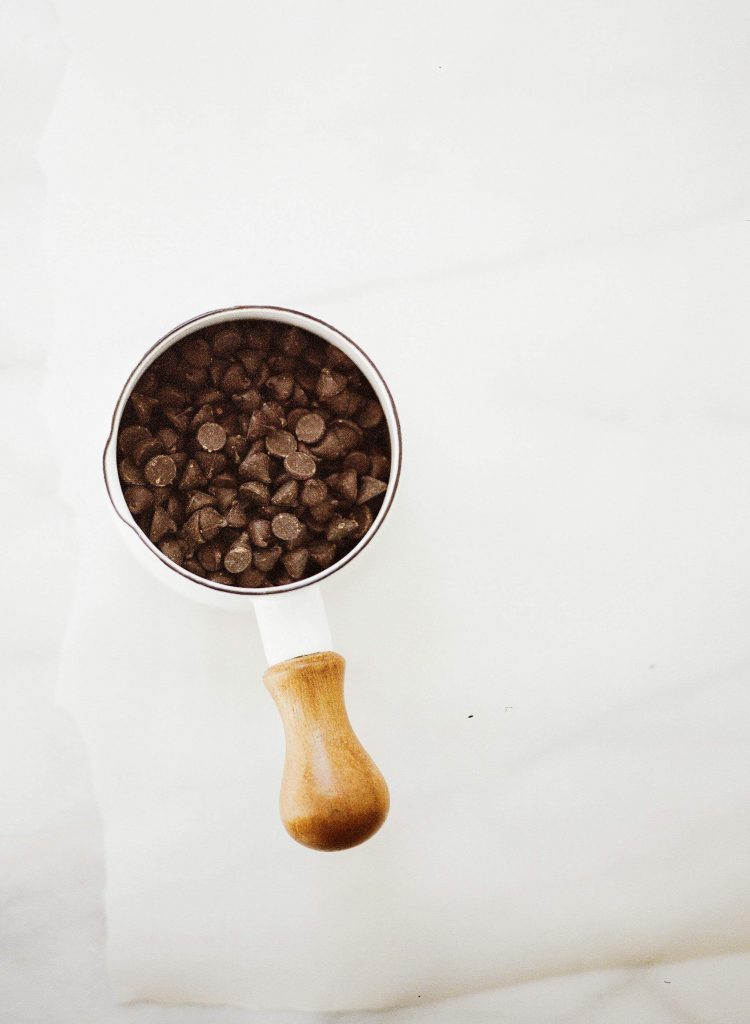
FAQs
How is cocoa powder made?
Well it all it all starts with the cacao tree, which is native to tropical regions in Central and South America, Africa, and Southeast Asia. When the pods ripen, they’re harvested and cracked open to reveal the beans. These beans are then fermented, a process that develops their complex flavor and aroma. After fermentation, the beans are dried in the sun or ovens. The dried beans are then roasted, which intensifies their chocolatey flavor and loosens their shells. The roasted beans are cracked and the shells are winnowed away, leaving behind the cocoa nibs. The nibs are ground into a thick paste called cocoa mass. This mass is then pressed to separate the cocoa butter, that is a fatty liquid, from the remaining cocoa solids. Finally, the cocoa solids are further processed to create cocoa powder.
Can I use coffee instead of cocoa powder?
While both coffee and cocoa powder come from beans and offer unique flavors, directly substituting coffee for cocoa powder in baking isn’t ideal. Coffee offers a distinctly different taste profile than cocoa powder. While coffee has a bitter, earthy flavor, cocoa powder has a rich, chocolatey taste. Replacing cocoa powder with coffee will result in a final product that tastes more like a coffee cake than a chocolate cake, potentially clashing with other flavors in your recipe.
Can I use hot chocolate instead of cocoa powder in a cake?
You can use hot chocolate instead of cocoa powder in a pinch, but there are some important things you need to consider. Overall, using hot chocolate as a substitute for cocoa powder can be convenient, but remember to adjust for sweetness, texture, and leavening potential. It’s not a perfect replacement, but it can still lead to delicious results in many recipes.
Can I use melted chocolate instead of cocoa powder?
You can definitely use melted chocolate instead of cocoa powder, but it’s not a 1:1 swap as it will affect both the flavor and the texture. You need to consider the type of chocolate you’re going to use. Dark chocolate (70% cacao or higher) will offer a more intense and slightly bitter flavor, while milk chocolate will be sweeter and creamier. You also need to remember that melted chocolate will add fat and moisture to your recipe, which can lead to a denser, fudgier texture. This can be desirable in some cases, like brownies or mousse, but might not be ideal for light and airy cakes. As a quick guide you can use 2 tablespoons of melted chocolate for every 3 tablespoons of cocoa powder. But remember, this is a starting point, as you might need to adjust quantities based on your specific recipe and desired texture.
By keeping these tips in mind, you can successfully use melted chocolate instead of cocoa powder.
Summary for Cocoa Powder substitutes
Okay – that’s you all sorted with suitable substitutes for cocoa powder.
So, when it comes to substituting cocoa powder, you’ve got a variety of options to play with.
- Unsweetened cooking chocolate is a solid choice, just melt it down and adjust sugar accordingly.
- Dark chocolate can work too, but watch out for the sweetness.
- Dutch-process cocoa is a great substitute if you want a smoother, less acidic flavor.
- Carob powder is a unique alternative, offering a slightly nutty taste.
- Roasted beet powder adds a natural sweetness and a hint of earthiness.
- Espresso powder can intensify the chocolatey flavor
- Cinnamon and nutmeg adds warmth.
- Hot chocolate powder is an easy swap.
- Chocolate chips or nibs can bring a delightful texture.
We have gathered together a lot more facts on ingredients such as herbs, spices, oils, nuts, etc. if you would like to learn some more.
Or if you need to swap out another ingredient have a look at our Substitutes section.
Table of Contents
- What is the best substitute for Cocoa Powder?
- What is Cocoa Powder?
- What can I substitute for Cocoa Powder?
- Cocoa Powder substitutes
- FAQs
- Summary for Cocoa Powder substitutes
